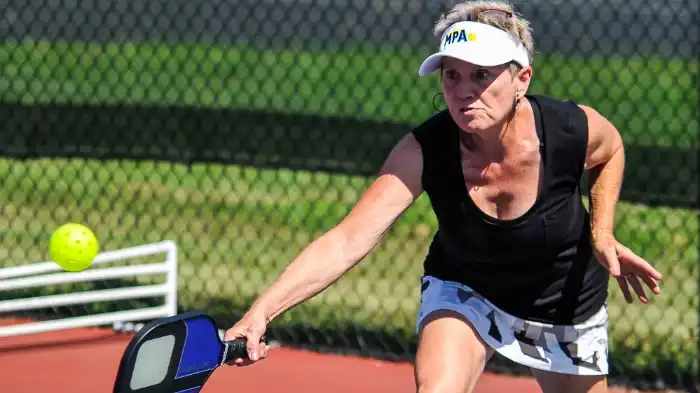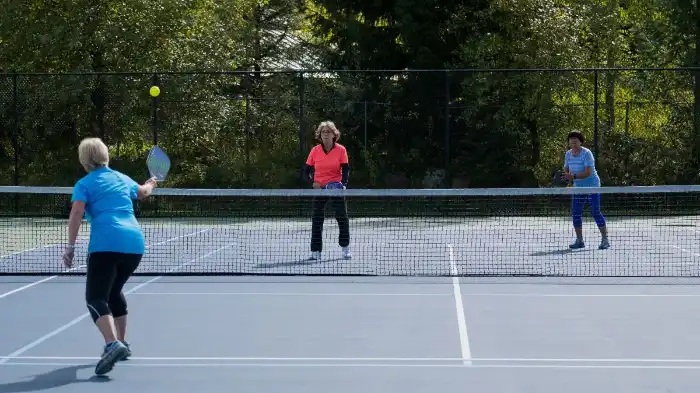Pickleball is a popular paddle sport that combines elements of tennis, badminton, and ping pong. It can be played by people of all ages and skill levels, making it an enjoyable activity for both beginners and experienced players. Like any sport, pickleball has its own set of rules that players must follow to ensure fair play and maintain the integrity of the game.
Regarding the rules of pickleball, many pickleball players or enthusiasts ask, “What are the 10 rules of pickleball?”. In this blog post, we are going to discuss the 10 rules of pickleball that you should be aware of.

What Are the 10 Rules of Pickleball?
Rule 1: Court Dimensions
The pickleball court measures 20 feet wide by 44 feet long for both doubles and singles play. The court is divided into two equal halves by a net that stretches across the middle. There is a 7-foot non-volley zone, often referred to as the “kitchen,” on each side of the net, where players are not allowed to enter unless the ball bounces. The court boundaries are marked by lines, and it is important to stay within these lines while playing.
Rule 2: Serve and Return
Before starting a pickleball rally, one player from each team must serve the ball diagonally into the opponent’s service court. The serve must clear the 7-foot non-volley zone and land within the opposite diagonal court. The returning team must let the ball bounce before striking it, while the serving team can volley or let the ball bounce. The serve and return continues until a fault is committed, resulting in a point for the opposing team.
Rule 3: Double Bounce Rule
The double bounce rule in pickleball requires that each team must allow the ball to bounce once on each side before volleying it. This rule applies to the serve and the return. Once both teams have executed one bounce, they can either volley the ball or let it bounce. This rule promotes longer rallies and provides equal opportunities for both teams to engage in the game.
Rule 4: Non-Volley Zone Violation
The non-volley zone, also known as the “kitchen,” extends 7 feet from the net on both sides. When a player is in the non-volley zone, they are not allowed to volley the ball. Violating this rule results in a fault. However, players can enter the non-volley zone to play a ball that has bounced within it, but they must exit before volleying the ball. It is crucial to understand and abide by this rule to maintain fair play.
Rule 5: Faults
A fault occurs when a rule is violated. Common faults in pickleball include stepping into the non-volley zone and volleying the ball, not clearing the net with the serve, hitting the ball out of bounds, and failing to let the ball bounce before returning it. Each fault results in a point for the opposing team.
Rule 6: Scoring
Pickleball uses a rally scoring system, which means that points can be scored by both the serving and receiving teams. A point is awarded for each fault made by the opposing team. The first team to reach 11 points, with a 2-point margin, wins the game. Matches are typically best-of-three games.
Rule 7: Switching Sides
Players must switch sides of the court after each point is scored. This ensures fairness and equal opportunity for both teams. Additionally, the serving team must alternate their serving position diagonally within the service court.

Rule 8: Fault Serve Rule
If a server faults by hitting the ball into the net or out of bounds, the serve switches to the other team. Unlike in tennis, there are no second serve attempts in pickleball. Each player only gets one chance to successfully execute the serve. It is essential to maintain accuracy and control while serving to avoid faults.
Rule 9: In-Out Calls
During a pickleball game, players must make in-out calls if there is a doubt about whether a ball has landed in bounds or out of bounds. The players on the opposing team are required to make fair and honest calls, as it is often difficult for the player hitting the ball to accurately determine its landing position. Honesty and integrity are valued in pickleball, so players should prioritize making accurate calls.
Rule 10: Player Positioning
When playing in doubles, both teammates must take turns hitting the ball, and the shots should be alternated between the partners. Positioning is key in pickleball to ensure efficient court coverage and teamwork. Players should communicate with each other to avoid confusion and prevent open areas on the court.
Conclusion
In conclusion, understanding “What are the 10 Rules of Pickleball” is fundamental for players of all skill levels. These rules govern court dimensions, serve and return protocols, the double bounce rule, non-volley zone restrictions, faults, scoring, and more. Embracing these guidelines ensures fair play, strategic engagement, and an enjoyable pickleball experience.
Whether you’re a beginner or an experienced player, adhering to these rules fosters a dynamic and competitive game. So, the next time you step onto the pickleball court, keep in mind the importance of these rules—they’re the framework that adds structure and excitement to this versatile paddle sport.
Frequently Asked Questions
The 10 rules of pickleball include court dimensions (20 feet by 44 feet), diagonal serve and return, adherence to the double bounce rule, avoiding non-volley zone violations, recognizing and preventing faults, scoring with a rally system to 11 points, switching sides after each point, making honest in-out calls, maintaining proper player positioning in doubles, and following the fault serve rule, where a server’s fault results in a switch to the opposing team without a second serve attempt. These rules collectively ensure fair play, strategic engagement, and a dynamic pickleball experience.
The serve must be diagonal, clearing the 7-foot non-volley zone and landing within the opposite diagonal court. The serving team can volley or let the ball bounce, while the returning team must let it bounce before striking.
Switching sides after each point ensures fairness, equal opportunity, and balanced playing conditions for both teams.
There is no specific limit to faults during a game, but each fault results in a point for the opposing team. Teams strive to minimize faults to maintain a competitive advantage.
Yes, players can step into the non-volley zone to hit a ball that has bounced within it. However, it is crucial to leave the zone before volleying the ball to adhere to the rules and avoid a fault.

